Types of Sutures
You are working in urgent care and you see a patient with a laceration pop up on your board. You start going through the files in your mind. I wonder what type of suture I will use; how long should these sutures stay in for, what type of suture will I tie?
Today we are going to discuss several of the many type of sutures as well as when they are indicated for use, suture material, and finally suture patterns that can be used.
Suture Types and Indication
There are several types of sutures that can be used depending on the location of the wound. Suture types include:
- Chromic
- Nylon
- glycolide/lactide polymer
- polypropylene
- poliglecaprone
- silk
Indications
Depending on what type of tissue that you are suturing will depend on what type of suture that you would want to use. Some examples of these include:
- Interrupted skin suturing when sutures will be removed later
- 4-0 Nylon
- Securing drains to the skin
- 2-0 Silk
- Repairing sutures for blood vessels
- 6-0 Prolene
- Vessel graft sutures for AAA, Femoral-Popliteal graft, or Carotid Artery grafts
- 5-0, 6-0 Prolene or Gortex
- Bowel repair sutures and for hemostasis in ligation of vessels or for tying over bolsters
- 3-0 Silk
- Achilles tendon repair
- #5 Ethibond or Fiberwire
- Mucosa, eye wounds
- Chromic
- Deep dermal, muscle, fascia, oral mucosa, genitalia wounds
- Glycolide/lactide polymer (Vicryl)
- Dermal, subcuticular wounds
- Polydioxanone
Indications for Tissue Adhesive
As opposed to sutures, there are some instances where tissue adhesive can be used instead. These include a wound that is:
- less than twelve hours old
- the patient must have no chronic conditions that might impair wound healing
- the wound must be linear
- not a result of mammalian bite
- no crossing a joint
- no devitalized tissue
- not crossing a mucocutaneous junction
- not infected
- not in a hair-bearing area unless hair opposition technique is being used
- and the wound must not be under significant tension.
Suture Material
Next, lets discuss suture materials. The big determining factor regarding which suture material to use will be dependent upon if you plan to leave the sutures in the skin and not remove them, or if want the patient to return to their primary care provider for suture removal.
Dissolvable Sutures
The material in which the suture is comprised matters regarding if the suture will dissolve or not. Some dissolvable sutures include:
- Vicryl Rapide
- 2 weeks
- Undyed Monocryl
- 3 weeks
- Dyed Monocryl
- 4 weeks
- Coated Vicryl
- 5 weeks
- PDS
- 9 weeks
- Panacryl
- 70 weeks
Rate Suture Dissolves
The rate in which a suture dissolves is dependent upon the suture type, size, and location in the body where the suture is placed. Additionally, some characteristic within the patient can affect how fast the suture will dissolve as well. If a patient is:
- Febrile
- has an infection
- protein deficiency
- if the suture is under high tension
The suture may dissolve faster.
Non-absorbable Sutures
Additionally, there are non-absorbable sutures as well, these lie on the skin and must be removed. If they are within the body, “buried”, they will be retained in the tissue. Non-absorbable suture materials include:
- Nylon
- Polypropylene
- Silk
Types of Suture Patterns
Lastly, we will go over different suture pattern that can be used when repairing a wound. Classically, single layer, simple interrupted sutures have similar cosmetic results for facial and general skin lacerations.
Simple Interrupted
Simple interrupted sutures are commonly used for general tissue approximation and can be used for most wound repair. To see a simple interrupted suture completion, see this video:
Running Sutures
Next for running sutures. When looking at the data regarding running sutures, these types of sutures have less dehiscence than simple interrupted sutures in wound repair. Simple running sutures are fast and effective for long lacerations. However, if one suture is cut by mistake or removed, then all sutures are lost, therefore, caution and attention must be used when completing this suture type.
Mattress Sutures
Next horizontal and vertical mattress patterns. Mattress sutures are used for everting wound edges. Additionally, half-buried mattress sutures are beneficial for everting triangular edges in flap repair.
Running Subcuticular Sutures
Lastly running subcuticular sutures are fast and effected in accurate skin edge apposition. This type of suture pattern is best used for closing clean wounds especially for surgical wound in the procedure labs or operating room.
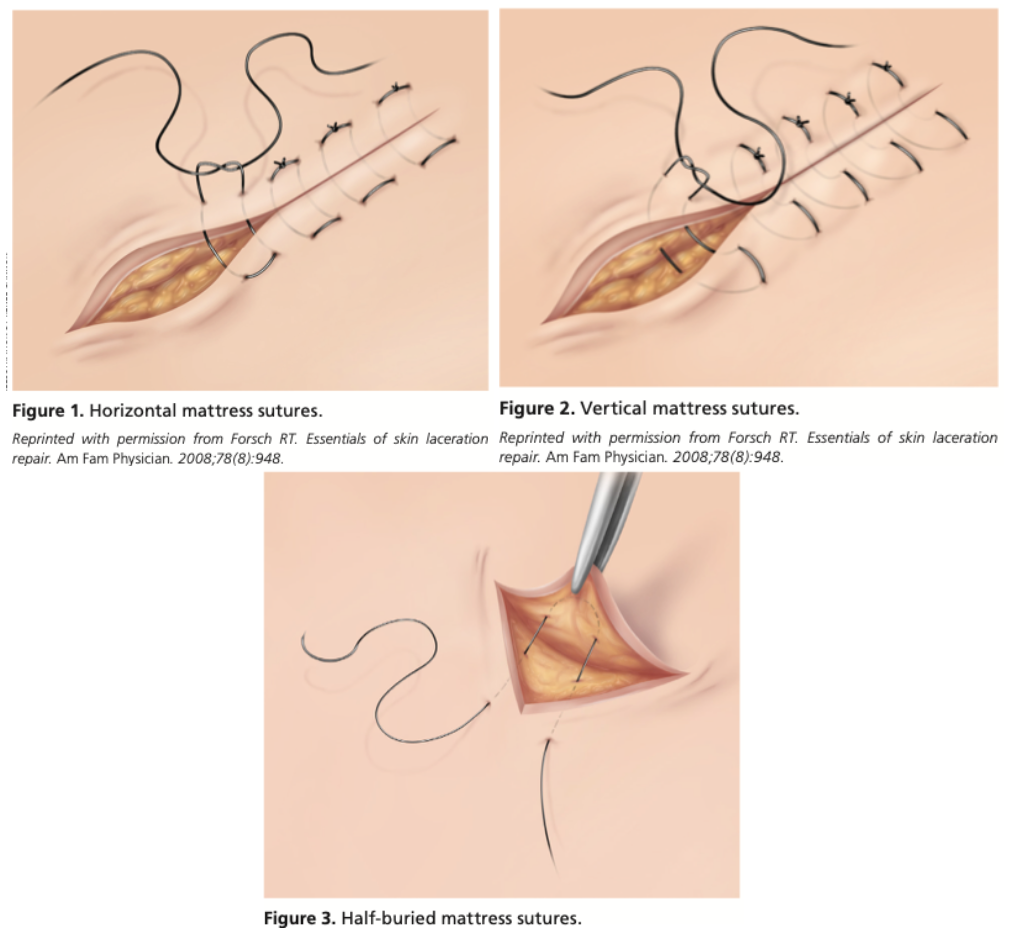
Additionally, here is a nice algorithm for the management, evaluation, and repair of laceration!
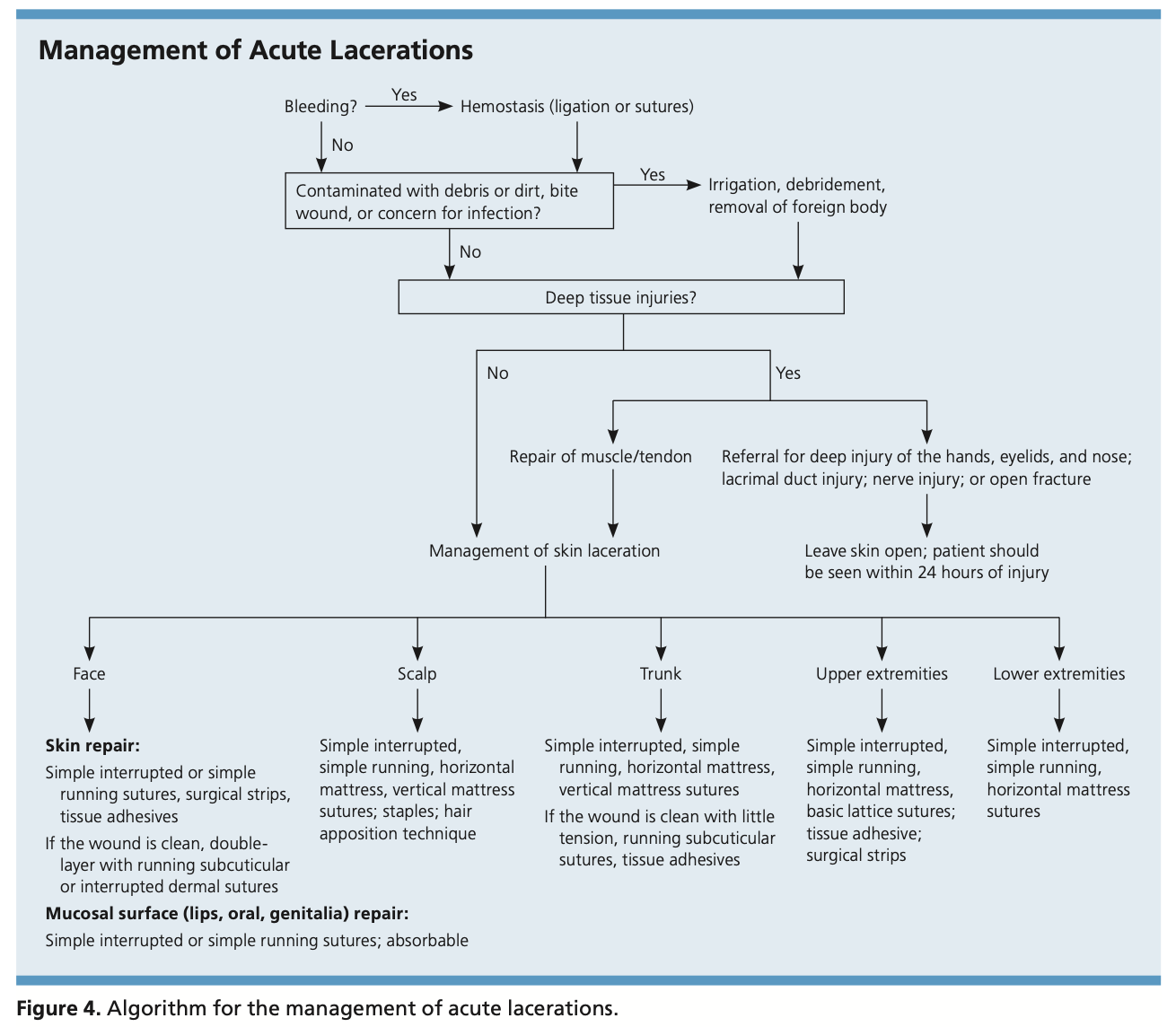
No matter if you practice in family medicine, emergency medicine, a surgical subspecialty, or urgent care, there is a common procedure that a provider must know how to complete efficiently. This is knowing how to suture a wound.
Today we will be discussing everything from:
- Suture selection
- Duration that sutures should remain in tissue
- Suturing basics.
So, let’s dive in!
Suture Size Selection
The first thing that a provider must decide when beginning to suture a wound is the type and size of the suture that would work best, or what your preference may be. You might hear a colleague or preceptor rattle off “give me a 4-0 Vicryl on a PS-2”, but what does this even mean?
The number, “4-0” refers to the size of the suture fiber. Vicryl is the type of suture, and PS-2 is the type of needle that the suture is attached to.
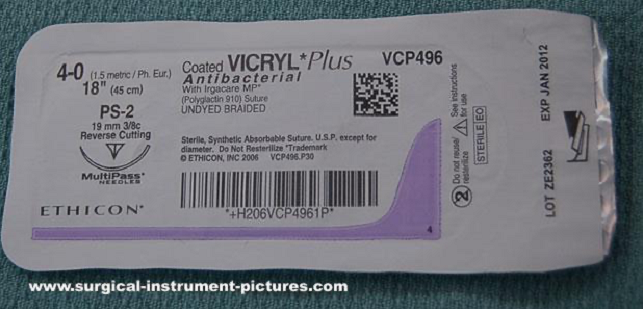
When to Use Smaller Sized Sutures (10-0, 9-0 and 8-0)
Next, for the size, the larger the number, the smaller the size of the fiber. Sutures that are 10-0, 9-0, and 8-0 are typically used in the most delicate surgeries. Commonly these are used in ophthalmic surgeries and for repairing small damaged nerves as well as in lacerations of the hand.
When to use 7-0 and 6-0
Sutures that are sized 7-0 and 6-0 are often used for repairing small vessels and arteries or for delicate facial plastic surgery. Other common uses may include vascular graft sewing, such as in a carotid endarterectomy.
When to use 5-0 and 4-0; and 3-0 and 2-0
5-0 and 4-0 sutures can be used in larger vessel repairs such as in an abdominal aortic aneurysm repair or skin closure.
Sutures sized 3-0 and 2-0 are used in skin closure when there is a lot of tension on the tissue, closure of muscle layers, or repair of the bowel in surgery.
Suture Material Selection – Absorbable
The material in which the suture is comprised matters regarding if the suture will dissolve or not. Some dissolvable sutures include:
- Vicryl Rapide
- 2 weeks
- Undyed Monocryl
- 3 weeks
- Dyed Monocryl
- 4 weeks
- Coated Vicryl
- 5 weeks
- PDS
- 9 weeks
- Panacryl
- 70 weeks
The rate in which a suture dissolves is dependent upon the suture type, size, and location in the body where the suture is placed. Additionally, some characteristics within the patient can affect how fast the suture will dissolve as well. If a patient is febrile, has an infection, protein deficiency, or if the suture is under high tension, the suture may dissolve faster.
Non-absorbable
Additionally, there are non-absorbable sutures as well, in which these often lie on the skin and must be removed. If they are within the body, “buried”, they will be retained in the tissue. Uses for non-absorbable sutures include:
- Interrupted skin suturing when sutures will be removed later
- 4-0 Nylon
- Securing drains to the skin
- 2-0 Silk
- Repairing sutures for blood vessels
- 6-0 Prolene
- Vessel graft sutures for AAA, Femoral-Popliteal graft, or Carotid Artery grafts
- 5-0, 6-0 Prolene or Gortex
- Bowel repair sutures
- 3-0 Silk
- Achilles tendon repair
- #5 Ethibond or Fiberwire
Braided Sutures vs. Non-braided or monofilament
The last two qualities to consider when choosing a suture is whether you would like the suture to be braided, and what type of needle that you would like to use. Braided sutures have strands that are woven together, such as Silk, Vicryl, and Ethibond. Non-braided or monofilament sutures have a single strand, and can include Monocryl, PDS, and Ethicon Nylon.
So, which do you choose? It is typically provider preference. Non-braided sutures cause less reactivity in the body, and are also not as prone to infection due to the lack of rough surface for bacteria to adhere to. Braided sutures have less of a tendency to loosen at the surgical knot surface, are stronger, and also provide a better grip on the tissue being sutured.
Needle Type – Tapered vs Cutting
As for the needle, tapered needles are used inside of the body, such as on bowel, fascia, or muscle where the tissue is more easily pierced. Options can include TP, CTX, CT, SH, CV, or BV.
Cutting needles are used for skin and very tough tissue, such as on bone and tissue. Cutting needle options may include FSLX, FSL, FS, PS, or P3.
How long do my sutures need to stay in for?
A common question after you suture a wound for a patient is, “how long do these need to be in for?” Well, if you choose an absorbable suture, they will dissolve on their own without removal. However, if a non-absorbable suture is chosen, then the length of time in which the suture needs to remain in depends on the location.

As you can see in the above table, sutures that are in the face can be removed after 3 to 5 days, whereas sutures that are in thicker areas of skin, such as the palms or soles of the feet should remain in 14 to 21 days before removal.
How to suture a wound
Lastly, we will go over briefly one way how to suture a wound as well as suturing basics. Below is a detailed description of a simple interrupted suture placement or instrument knot tie.
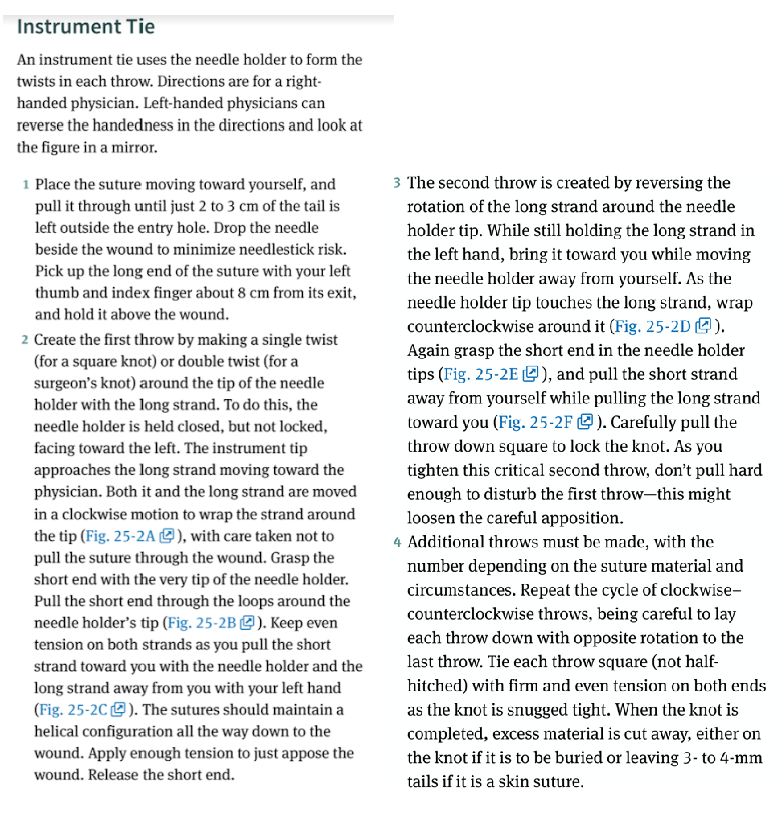
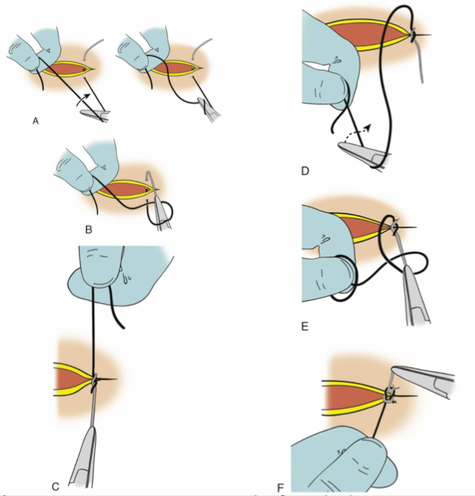

Sources
- MedGeeks
- Am Fam Physician. 2017;95(10):628-636. Copyright © 2017 American Academy of Family Physicians
- Pfenninger and Fowler’s Procedures for Primary Care
- Family Practice Notebook
- Surgical Instruments and Suture Material Lecture. Southern Illinois University School of Medicine Physician Assistant Program